When reading about audio products, testing methods, or sound design, you'll often come across terms like white noise and pink noise. But 'noise' here doesn't mean background sound. These types of noise are specific signal types used in technical tasks like measurement, calibration, and audio analysis. You'll also find them in more everyday settings, such as sleep apps.
In this article, we'll explain what the differences between pink noise vs. white noise actually are. We'll look at how they differ in frequency content and where each is commonly used in the worlds of audio research, production, and testing. We'll also explore other 'colors' of noise, like brown, blue, grey, and velvet. We'll take a closer look at why pink noise is so widely used in the audio world, how we use it in our headphone testing at RTINGS, and why we moved away from sine sweeps for certain measurements. Whether you're setting up your own gear, wondering more about how we test, or just curious about these strange signals you keep reading about, read on to find out what all the noise is about.
What Is White Noise?
White noise is a kind of random audio signal. It may sound like pure chaos, but it actually follows a very specific rule: it contains all audible frequencies from 20Hz to 20kHz at equal intensity. In other words, every slice of the frequency range, whether 40Hz to 50Hz or 900Hz to 910Hz, has about the same amount of energy. The name is drawn by analogy to white light: just like white light contains all visible colors, white noise contains all audible frequencies.
What makes it noise, rather than a recognizable tone, is the way those frequencies are combined. Each frequency component (or sine wave) starts with a random amplitude and phase, which creates a waveform that constantly shifts over time. That randomness makes the signal fluctuate chaotically, without any repeating pattern or stable pitch. So even though it technically includes every audible tone, it doesn't sound musical; it sounds like a steady hiss or static, like that from an untuned TV or radio.
Most of us will hear white noise as bright and hissy because of how our ears work. Human hearing is more sensitive to mid and high frequencies than to deep bass. And because there are so many more high-frequency bands packed into the top end of the spectrum, all that treble energy piles up where we notice it most. The result? A sound that can feel harsh or fatiguing, especially at high volumes, even though the energy is technically very evenly spread out.
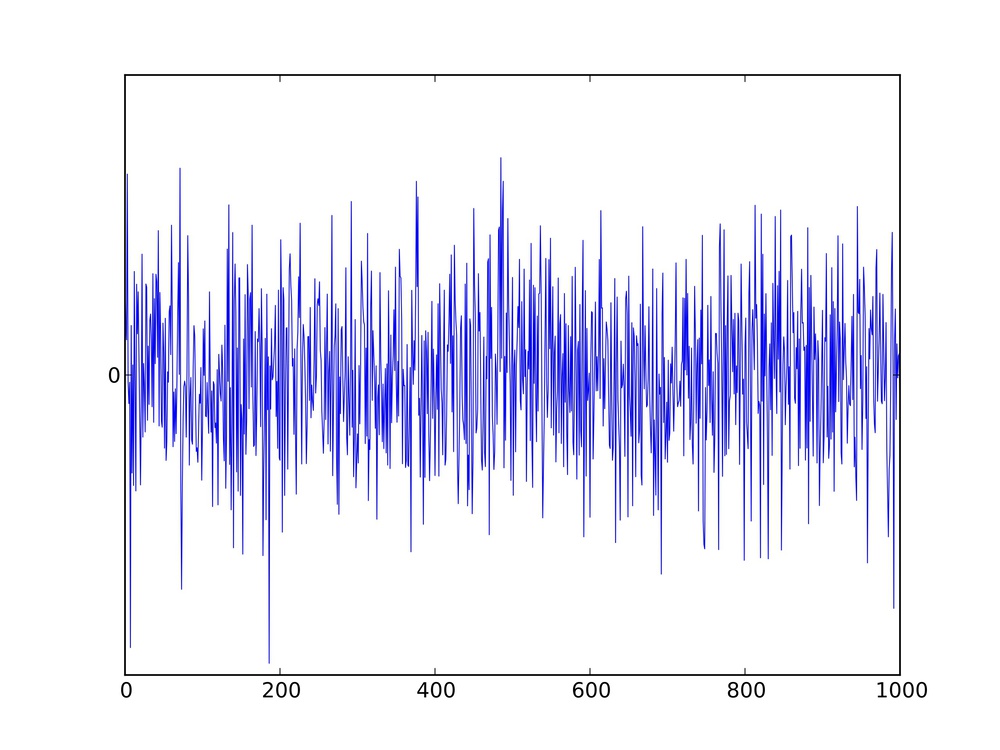
What Is Pink Noise?
Pink noise is another type of broad-spectrum noise, but it's shaped differently from white noise. Instead of having equal energy in every slice of the spectrum, pink noise has equal energy per octave. That distributes the energy in a way that matches how we hear sound, which makes pink noise useful in listening and other technical tests.
Our ears don't treat every frequency as equal. We hear octaves, doublings of frequency, as equal steps in pitch. For example, the distance between 100Hz and 200Hz sounds the same to us as the distance between 1,000Hz and 2,000Hz, even though one gap is 100Hz wide and the other is 1,000Hz wide. This is called logarithmic perception. The name pink noise also arises from analogy to light: a visual spectrum that follows the same power law as pink noise looks pinkish.
Pink noise follows that structure: it gives each octave band the same amount of energy. So the total energy from 40Hz to 80Hz is the same as from 80Hz to 160Hz, 160Hz to 320Hz, and so on. That's why pink noise usually sounds smoother and more natural to our ears than white noise, even though both are technically full-spectrum and random. If white noise is like a sharp hiss, pink noise is closer to the sound of steady rainfall.
Because of this natural balance, pink noise is widely used in audio engineering and product testing. Each octave contributes equally to the total sound energy, making it a fair and realistic reference. It's sometimes called '1/f noise' because its power decreases as frequency increases. The drop off is about 3 dB per octave across the full spectrum.
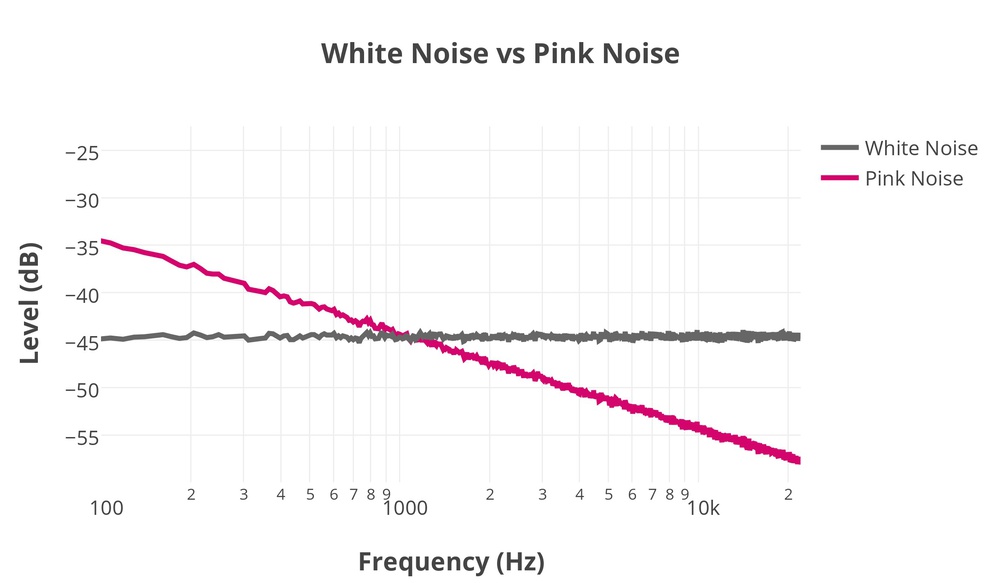 |
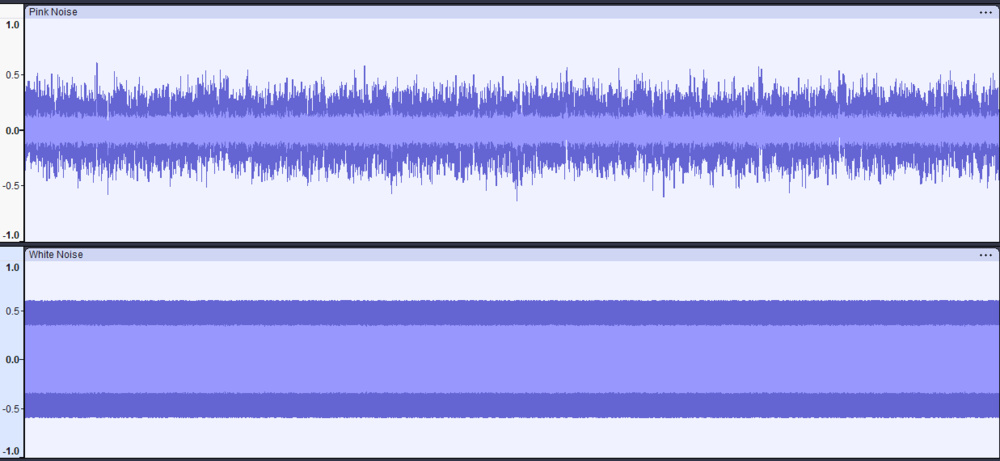 |
The Other Colors of Noise: Brown, Blue, Violet, Grey, and Velvet
But there's more to the noise story than just white noise vs. pink noise. While pink and white are the most common forms of broadband noise signals you'll come across when researching audio-related queries, there are many other kinds of 'colors.' These aren't actual colors, of course. They're names engineers use to describe how a noise signal is shaped across the frequency range. Each one has a different balance of bass, mids, and treble. These colored noises can be thought of as filtered versions of white noise, with certain frequencies relatively louder or quieter.
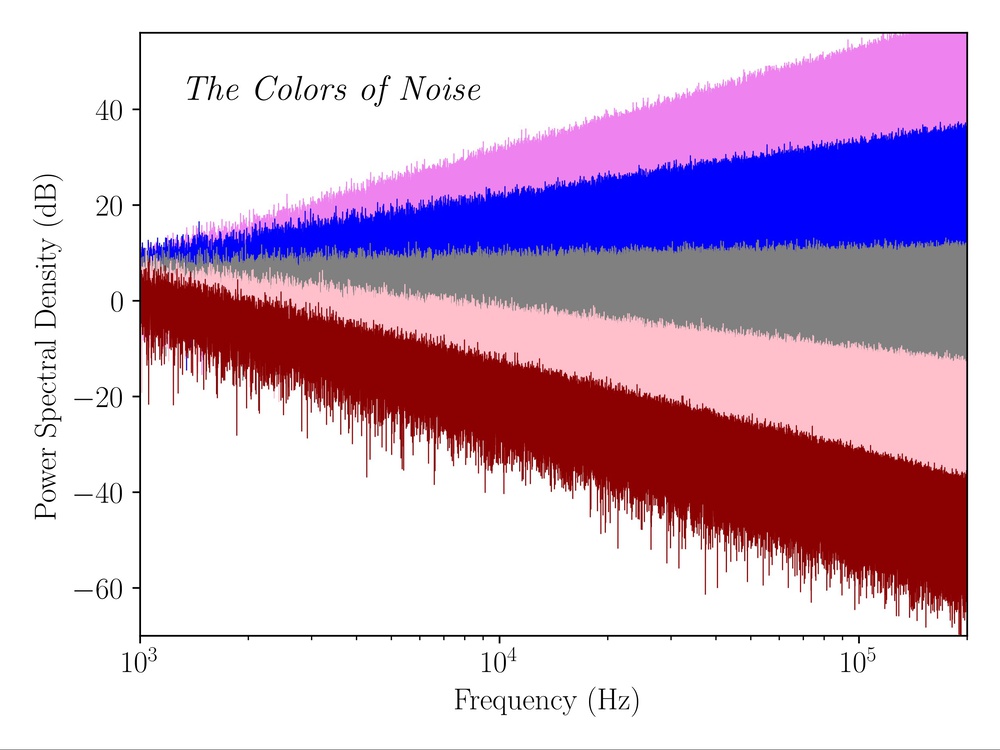
Brown Noise (sometimes called Red Noise)
Brown noise sounds deeper and fuller than pink noise. It puts more energy in the low-end and much less in the highs, so it comes across as warmer than pink and white noise. In technical terms, the energy level drops off by about -6 dB with each higher octave. That means as you move up in frequency, the sound gets noticeably quieter.
Some people use brown noise to help with focus or relaxation. Many find its warmer sound more calming than pink noise and, therefore, more useful as a sleep aid.
It's called 'brown' not because of a color but after Brownian motion, a type of natural, random movement you see when particles bounce around in a liquid. Brown noise is based on a similar idea: each moment in the signal builds on the last, which makes the changes smoother over time. That smoother movement emphasizes low frequencies (which are slower, longer sound waves) and softens the highs, giving brown noise its warm character.
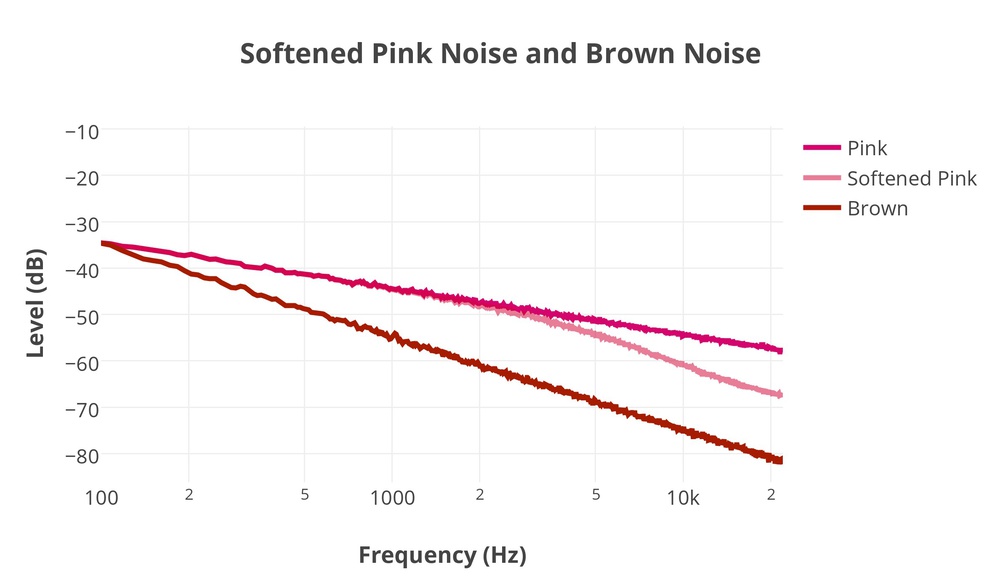
Blue Noise
Blue noise is basically the opposite of brown noise. It has more energy in the treble and very little in the bass, rising by about +3 dB per octave. The result is a bright, high-pitched hiss. Because it's so top-heavy, blue noise isn't typically used for listening or speaker testing. However, it does have specialized uses in digital audio and image processing, particularly in a process called dithering, where it helps reduce visible or audible artifacts.
Violet Noise (Sometimes Called Purple Noise)
Violet noise is even brighter than blue, with energy rising at +6 dB per octave. This piercing sound is unpleasant to listen to.
Grey Noise
Grey noise is a version of white noise that's been adjusted to match how we actually hear loudness across the frequency range. Our ears are more sensitive to some frequencies than others, especially in the low-treble and upper-mids, so raw white noise can sound uneven or harsh.
Grey noise corrects for this by boosting and cutting different bands so that all frequencies sound equally loud to us, even if they're not technically equal in energy. This type of noise can be helpful in hearing tests or for soothing tinnitus, because it presents a more balanced sound to the ear.
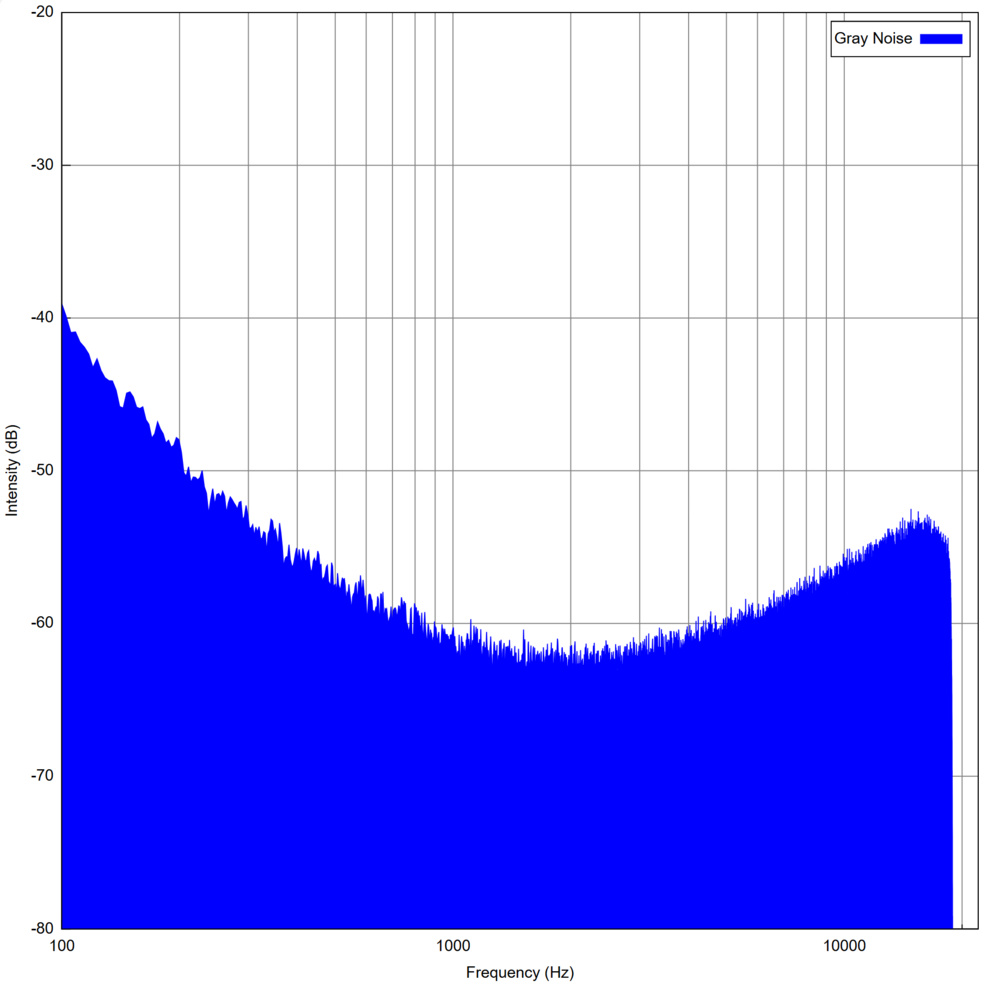
Velvet Noise
Velvet noise is quite different from the other types we've talked about. It's not a continuous stream of sound like white or pink noise, but is a signal made up of very short, randomly timed digital 'clicks' that jump up or down in volume for just a fraction of a second. In technical terms, it consists of samples that take only the values -1, 0, or 1. Velvet noise doesn't have a fixed frequency response in the way that white, pink, or brown noise do, because it's not defined by a spectral slope. Instead, its frequency content depends on how densely the samples are spaced.
If you play just a few of these clicks per second, velvet noise sounds sparse and percussive, like scattered taps or pops. But if you increase the number of clicks to thousands per second, those tiny impulses start to blend together into a soft, even hiss that feels lighter and smoother than white noise. Hence the name: it has a softer texture, like velvet.
This softness doesn't come from its frequency content (high-density velvet noise has a spectrum that's roughly flat, like white noise) but from how it behaves over time. While white noise jumps around chaotically from moment to moment, velvet noise changes more gently. The waveform has a smoother, less jagged time-domain structure, which makes it more pleasant to the ear, even when the frequency balance is similar.
Velvet noise isn't common for everyday listening, but it's used behind the scenes in professional audio processing, especially in artificial reverb and 3D sound effects. That's because the signal is easy to generate, takes up very little processing power, and blends well with other audio. More recently, it's started showing up in relaxation and mindfulness apps as a softer, less aggressive type of background noise.
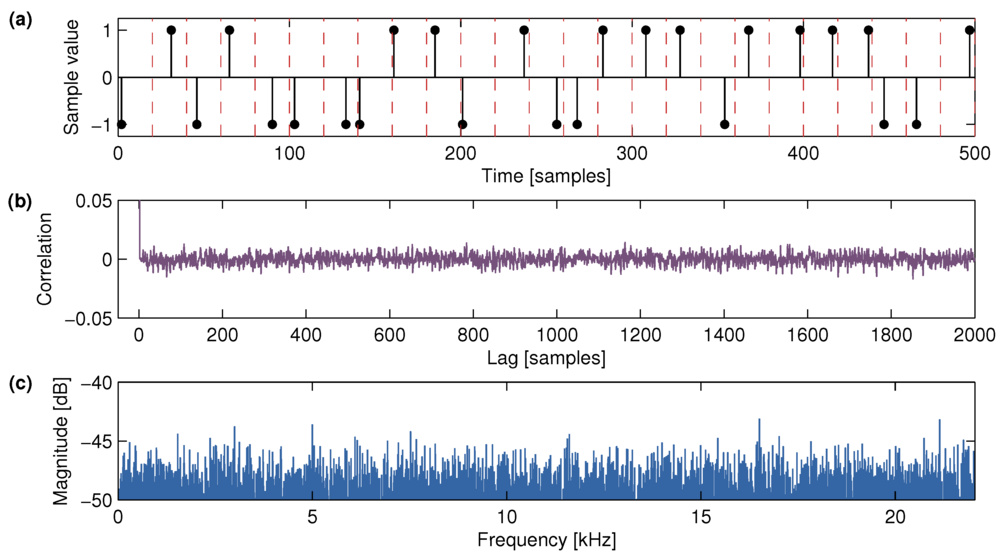
How Does RTINGS.com Use Pink Noise in Headphone Testing?
At RTINGS, we use pink noise to evaluate several aspects of headphone performance. Because it delivers equal energy per octave, pink noise lets us assess how headphones respond across the full frequency spectrum in a consistent and repeatable way. Here are a few important tests where pink noise plays a central role:
Test Rig Calibration
We use a band-passed pink noise signal to calibrate our HMS II.3 testing rig, which we use when measuring a pair of headphones' PRTF and microphone. That said, we use a sine wave to calibrate our Brüel & Kjær HATS Type 5128-B rig, which we use for measuring things like Raw Frequency Response.
Noise Isolation - FULL RANGE (Passive and Active Noise Cancelling)
To measure a headphone's Noise Isolation - Full Range score, we play a broadband pink noise sample through speakers in our test chamber and measure how much of that sound makes it through the headphone to the test microphones inside our Brüel & Kjær HATS Type 5128-B (B&K) dummy head. This simulates how well a headphone can block out ambient noise in real-world settings.
We originally used sine sweeps (a single tone that glides from low to high frequencies) for this test, but those didn't always reflect how real-world background noise behaves. This was especially true for active noise cancelling (ANC) headphones, which adapt dynamically to their environment. Because a sine sweep moves quickly, it sometimes doesn't give ANC systems enough time to fully engage.
Now, we use steady pink noise (alongside real-world audio samples), which lets ANC systems respond properly, giving us more realistic isolation measurements. It also helps us compare models fairly, since all frequencies are tested at once.
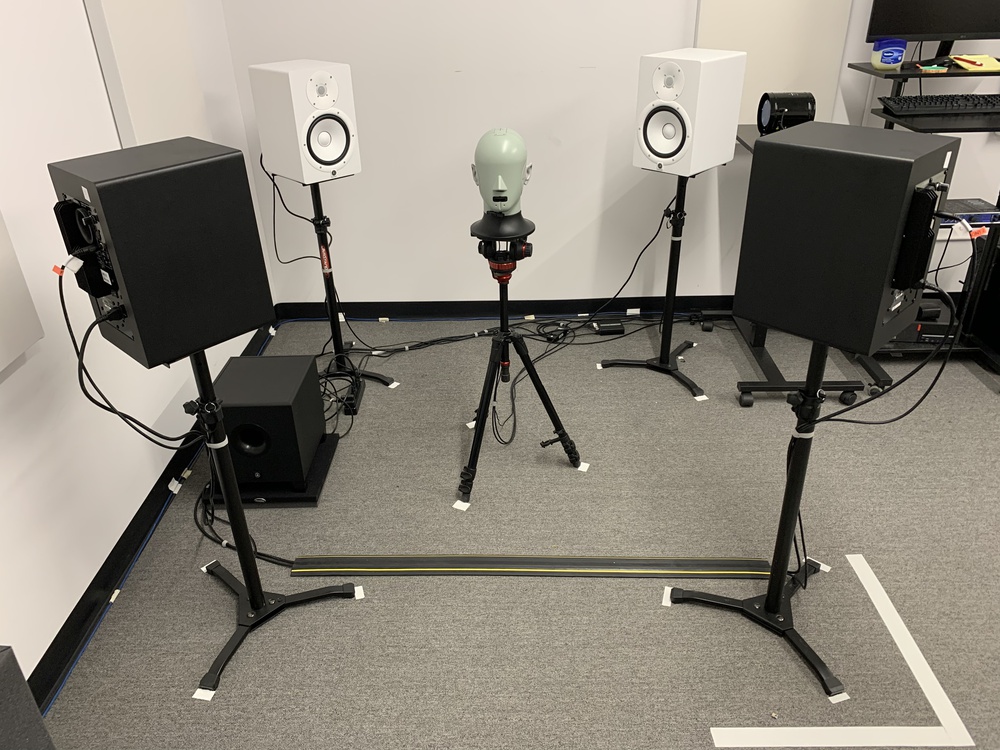 |
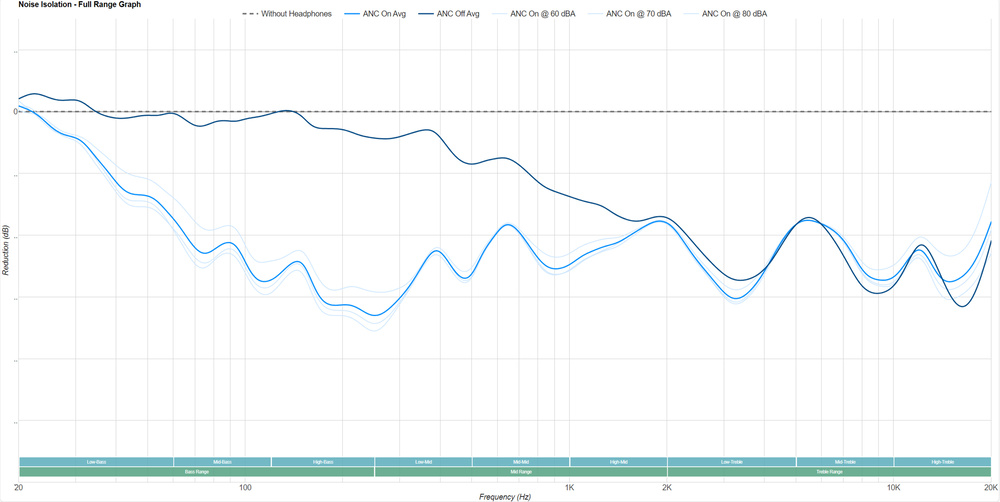 |
Sound Leakage
Our Sound Leakage test measures how much sound escapes from the headphones and could be heard by people nearby. It's the inverse of noise isolation. To standardize this test, we feed the headphones a calibrated pink noise signal and measure the level of sound leaking out.
We calibrate each pair of headphones to output 100 dB SPL using pink noise within the 250Hz to 2kHz range, where sound leakage is most noticeable; remember the grey noise spectrum above. Using pink noise ensures that all relevant frequencies are present, so the results reflect the headphone's actual leakage performance and not quirks in the test signal.
Microphone Noise Handling (Speech-to-Noise Ratio)
For headphones with built-in microphones, we run a Noise Handling test to measure how well the mic can separate your voice from background noise. We report this as a Speech-to-Noise Ratio (SpNR), which tells you how much louder your voice is compared to the surrounding noise in the mic's recording.
To simulate both voice and background sound, we use a mouth simulator to play pink noise (standing in for speech) and surround it with ambient noise from speakers. Pink noise may not sound like a real voice, but it covers all speech-relevant frequencies evenly, making it a good stand-in for a consistent test signal.
We then record what the headphone's mic picks up and calculate how many decibels louder the 'speech' is than the noise. A higher SpNR means the mic isolates your voice better in noisy environments.
Headphone Burn-In
Pink noise is even featured in our headphone burn-in tests. When we explored whether break-in time affects sound quality, we played pink noise through headphones in repeated 50-minute sessions to expose the drivers to a wide range of frequencies. The result? In most cases, we found little to no audible change, suggesting that burn-in has minimal impact.
Technical USES AND SCIENTIFIC RESEARCH
Pink noise is one of the most widely used and useful tools in audio testing more generally. It's not just for headphones! It's used to measure frequency response, sound isolation, distortion, and more. Because it covers all frequencies evenly across octaves, it simulates real-world listening conditions more effectively than single tones or narrow-band signals.
It's commonly used to tune speaker systems, especially in studios and live venues, by playing pink noise through speakers and measuring how the room responds across all the frequencies. It's also used to calibrate cinema sound systems, set reference loudness levels in broadcasting, and perform acoustic measurements in treated spaces.
White noise is also useful in some technical tests. It's sometimes used to create signal-to-noise ratio measurements and in psychoacoustic investigations, where researchers use it to create controlled listening environments. White noise can even help us distinguish between different tones better.
Sleep Aids and IMPROVED FOCUS
White noise is often associated with sleep machines and background noise apps. The idea is that its steady, high-frequency-rich hiss helps mask sudden sounds; because the noise contains all audible frequencies, it can drown out everything from barking dogs to hallway chatter. Many people use it to fall asleep or increase privacy in shared spaces.
That said, many prefer softer noise types like pink or brown noise for sleep. Some workplaces use pink noise machines (such as this one by Vibra-Sonic) to improve office productivity. One study found that participants exposed to pink noise while sleeping experienced deeper, more restorative sleep, and that it even led to improved memory in older adults. Pink noise has also been shown to help improve focus in people with ADHD.
Nowadays, manufacturers of dedicated sleep earbuds like the Bose Sleepbuds II or Ozlo Sleepbuds will even ship them with libraries of different kinds of noise to help you doze off.
Audio Production and Mixing
Some mixing engineers use a technique where they play pink noise quietly and bring up track levels one by one until each element is just audible. Because pink noise is evenly spread across octaves, it serves as a useful full-spectrum reference.
White noise, while less useful for calibration, plays a role in sound design. Synthesizers often use it to create snare hits, wind sounds, or special effects. Adding white noise can brighten a mix or simulate ambient textures like spray or static. For example, EDM producers like to use white noise swoosh sounds when reaching a big drop.

Headphone Calibration And EQ
If you're tweaking your own EQ settings, pink noise can be a helpful tool for dialing in a more balanced sound. Because it contains equal energy per octave, pink noise provides a consistent full-range signal that makes it easier to hear what each EQ band is doing. For instance, boosting 100Hz will make the sound boomier, while raising 4kHz will make it crisper or more piercing.
This approach isn't scientific, but it's a useful ear-based method for detecting peaks, dips, or tonal imbalances in your headphones. It's especially helpful if you don't have access to measurement gear but want to move your sound closer to neutral. Just remember to keep the volume moderate: pink noise may sound smoother than white, but prolonged listening can still be fatiguing, and human hearing isn't linear, so always check your results against real-world audio recordings. Read more about how to EQ your headphones.
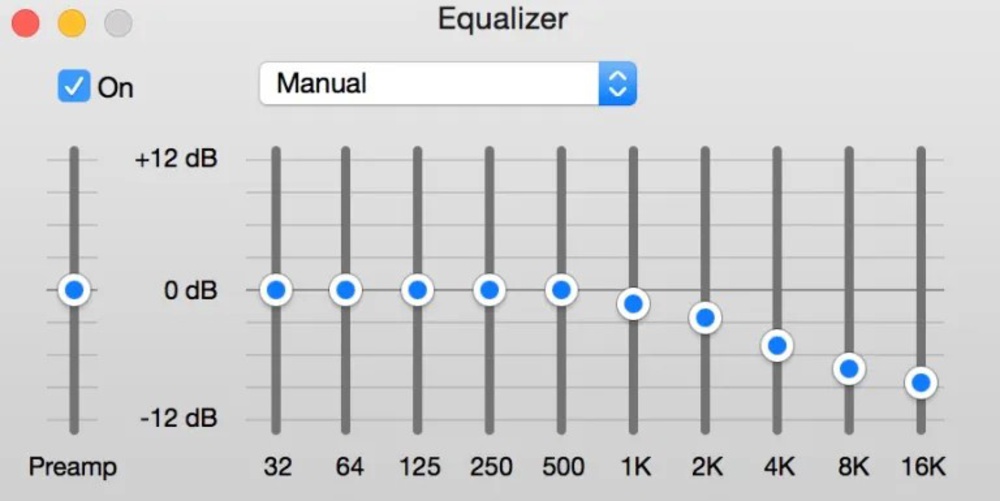 |
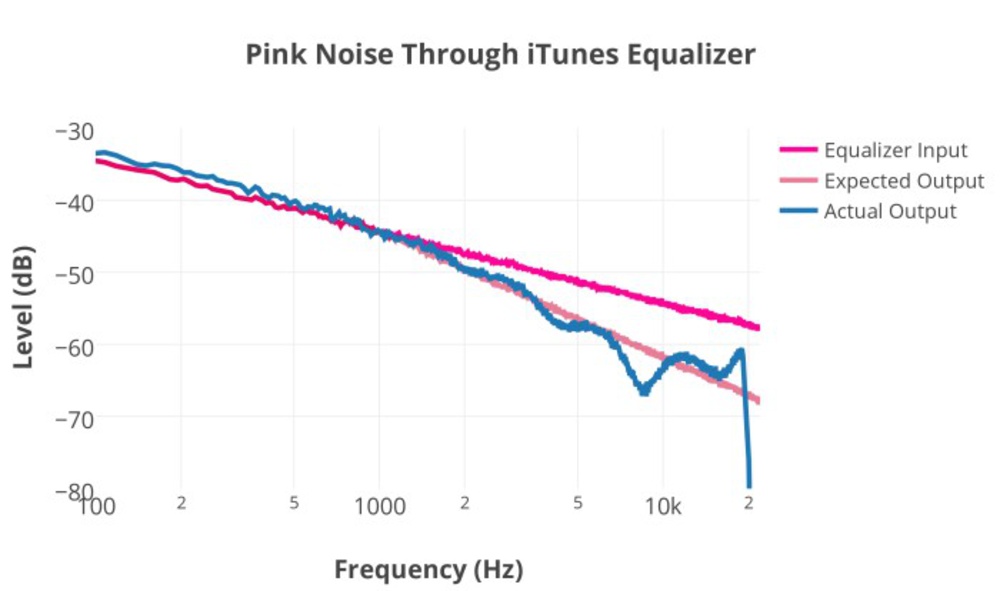 |
Conclusion
Tea vs. coffee, Ronaldo vs. Messi, white noise vs. pink noise. These are the age-old questions we must all struggle with. When it comes to noise, both white and pink are essential tools in audio testing, each with a distinct role. White noise covers all audible frequencies at equal intensity, which is why it's commonly used for sound masking and sleep aids, though it can sound harsh. Pink noise, with equal energy per octave, offers a more natural, balanced profile and is the preferred signal for calibration, speaker tuning, and headphone testing. That's why RTINGS uses pink noise to evaluate noise isolation, leakage, and microphone performance: it reflects human perception better than white noise or sine sweeps. Other colors like brown, blue, grey, and velvet have niche uses, but pink noise remains the go-to for accurate, human-centered, full-spectrum analysis. Whether you're reviewing specs, adjusting EQ, or just looking for a better night's sleep, understanding these noise types can help you make sense of the hiss behind the science.
Recent Updates
- 07/28/2025: We created this article to help answer common questions from our readers.